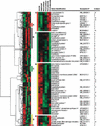Gene expression profiling of embryo-derived stem cells reveals candidate genes associated with pluripotency and lineage specificity
- PMID: 12466296
- PMCID: PMC187571
- DOI: 10.1101/gr.670002
Gene expression profiling of embryo-derived stem cells reveals candidate genes associated with pluripotency and lineage specificity
Abstract
Large-scale gene expression profiling was performed on embryo-derived stem cell lines to identify molecular signatures of pluripotency and lineage specificity. Analysis of pluripotent embryonic stem (ES) cells, extraembryonic-restricted trophoblast stem (TS) cells, and terminally-differentiated mouse embryo fibroblast (MEF) cells identified expression profiles unique to each cell type, as well as genes common only to ES and TS cells. Whereas most of the MEF-specific genes had been characterized previously, the majority (67%) of the ES-specific genes were novel and did not include known differentiated cell markers. Comparison with microarray data from embryonic material demonstrated that ES-specific genes were underrepresented in all stages sampled, whereas TS-specific genes included known placental markers. Investigation of four novel TS-specific genes showed trophoblast-restricted expression in cell lines and in vivo, whereas one uncharacterized ES-specific gene, Esg-1, was found to be exclusively associated with pluripotency. We suggest that pluripotency requires a set of genes not expressed in other cell types, whereas lineage-restricted stem cells, like TS cells, express genes predictive of their differentiated lineage.
Figures




References
-
- Adinolfi S, Bagni C, Castiglione Morelli MA, Fraternali F, Musco G, Pastore A. Novel RNA-binding motif: The KH module. Biopolymers. 1999;51:153–164. - PubMed
-
- Astigiano S, Barkai U, Abarzua P, Tan SC, Harper MI, Sherman MI. Changes in gene expression following exposure of nulli-SCCl murine embryonal carcinoma cells to inducers of differentiation: Characterization of a down-regulated mRNA. Differentiation. 1991;46:61–67. - PubMed
-
- Beddington RS, Robertson EJ. An assessment of the developmental potential of embryonic stem cells in the midgestation mouse embryo. Development. 1989;105:733–737. - PubMed
-
- Bierbaum P, MacLean-Hunter S, Ehlert F, Moroy T, Muller R. Cloning of embryonal stem cell-specific genes: Characterization of the transcriptionally controlled gene esg-1. Cell Growth Differ. 1994;5:37–46. - PubMed
Publication types
MeSH terms
Substances
LinkOut - more resources
Full Text Sources
Other Literature Sources
Molecular Biology Databases
